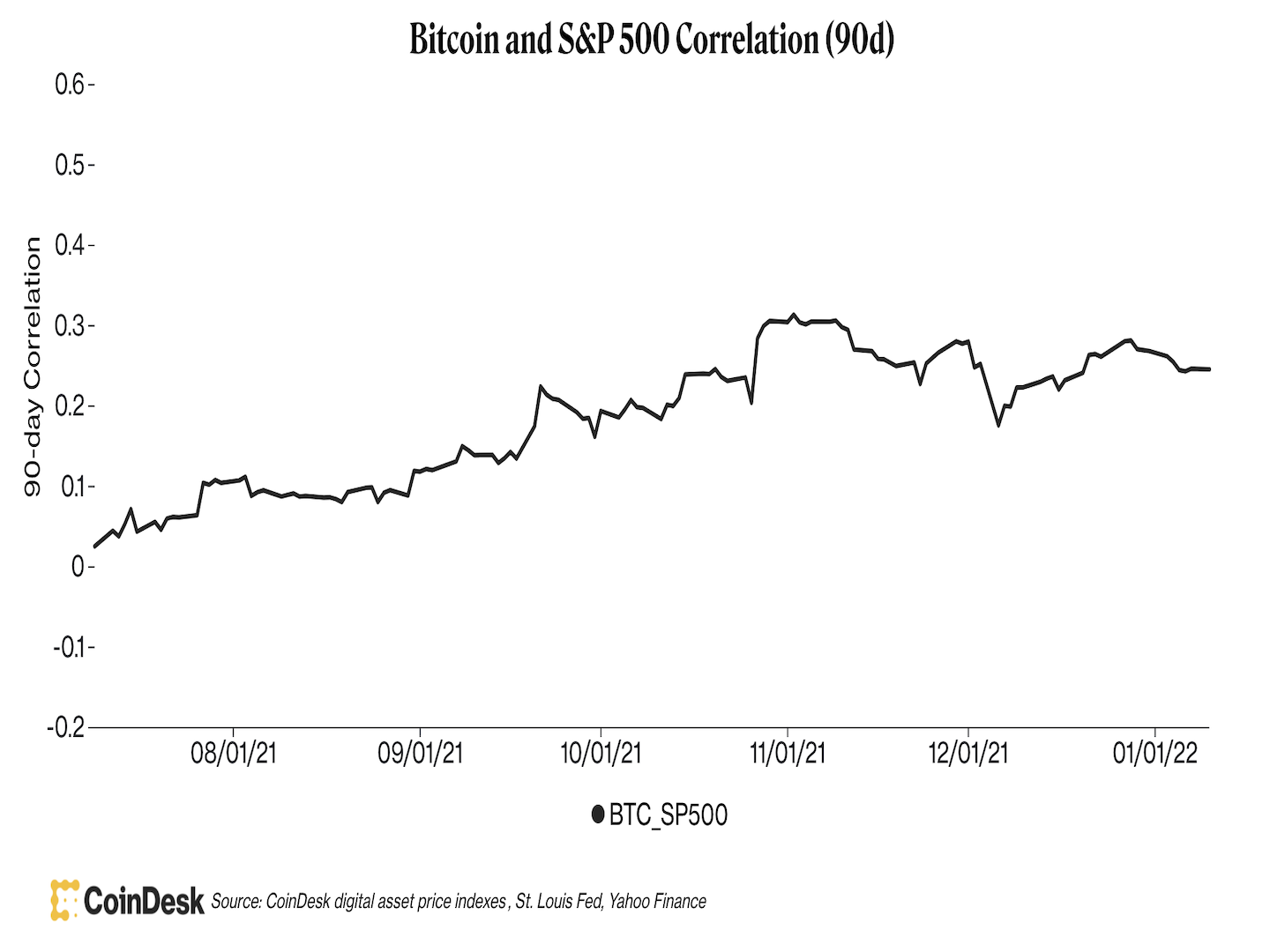Bitcoin rose toward $43,000 on Tuesday and is up about 3% over the past 24 hours. Several alternative cryptocurrencies (altcoins) such as MATC and FTM were up about 14% over the same period, suggesting a greater appetite for risk among investors.
It appears that bullish sentiment is starting to return to both crypto and equity markets, at least over the short term. Technical indicators suggest that BTC is at its most oversold level since December, which could encourage some traders to buy on the dip, although upside could be limited toward $45,000.
The sell-off has had a negative impact on crypto mining stocks over the past couple of months. Shares of the U.S.-listed mining companies Marathon Digital Holdings (MARA), Riot Blockchain (RIOT) and Bit Digital (BTBT) have dropped more than 50% each since Nov. 10.
Still, some miners appear to be unfazed by the price dip. For example, bitcoin mining firm Bitfarms purchased 1,000 bitcoins worth $43.2 million during the first week of January.
For some traders, however, losses are starting to add up. Blockchain data shows that more traders are selling BTC at a loss, or below their cost basis. “In May 2021 (during a sharp sell-off) we’ve seen a similar type of behavior when the market kept selling at a loss for an extended period of time,” CryptoQuant wrote in a blog post on Tuesday.
Latest prices
Bitcoin (BTC): $41,785, +2.33%
Ether (ETH): $3,239, +5.02%
S&P 500: $4,713, +0.92%
Gold: $1,822, +1.31%
10-year Treasury yield daily close: 1.74%
For now, it appears that most buyers are remaining on the sidelines, especially ahead of the U.S. consumer price index (CPI) report, which will be released on Wednesday.
“The market expects the CPI to rise 7.1% for the year through December and 0.4% over the month. If the figure released is larger than expected, we can expect further sell pressure for bitcoin,” Marcus Sotiriou, an analyst at U.K.-based digital asset broker GlobalBlock, wrote in an email to CoinDesk.
“Due to the selling we have seen in recent weeks, the downside for BTC is limited in the short term, even with higher-than-expected inflation data on Wednesday,” Sotiriou wrote.
Rising correlation with stocks
The chart below shows bitcoin’s 90-day correlation with the S&P 500 approaching its highest level in about a year. Some analysts are concerned that macroeconomic risks facing equities could weigh on crypto prices this year.
“Cryptocurrencies are on a par with growth stocks – they are sensitive to the dynamics of interest rates,” Alex Kuptsikevich, an analyst at FxPro, wrote in an email to CoinDesk. Higher interest rates mean company earnings over the next few years are worth less today, which can result in lower valuations and stock prices.
“At the same time, we must not forget that cryptocurrencies are more mobile, that is, they sometimes lose twice or three times more than the Nasdaq. If so, then cryptocurrencies are far from the bottom, since the process of normalizing interest rates in financial markets is far from complete,” Kuptsikevich wrote.
Other analysts expect bitcoin’s correlation with the S&P 500 to eventually decline this year.
“Bitcoin’s correlation with equities won’t hold up this year as stocks are only a few percentage points from record highs, while bitcoin is down around 40%,” Edward Moya, an analyst at Oanda, wrote in an email to CoinDesk.
“The focus over the next few months will be the Fed’s aggressive rate hiking cycle and how quickly they shrink the balance sheet, which could be much more negative for stocks than bitcoin,” Moya wrote.
Moya expects an economic recovery in countries outside the U.S. later this year could lead to a weaker dollar. In turn, a lower dollar will reduce inflationary pressures and provide support for assets deemed to be risky such as cryptocurrencies and equities.
And over the long term, economic factors will continue to affect crypto and equity prices alike, especially as more traditional investors gain exposure to both assets, he said.
“What's different between now and the much larger drawdown in 2018 is we are seeing more permanent capital that has come into the space within the last year or so. That can mean more correlation with the traditional markets," Paul Veradittakit, a partner at Pantera Capital, a crypto hedge fund, said during an interview on CoinDesk's "First Mover" show.
Altcoin roundup
Near and Cosmos outperformed: Tokens of Near (NEAR) and Cosmos (ATOM) were among the only gainers for major cryptocurrencies in the past 24 hours. NEAR posted gains of 17% in the past 24 hours and ATOM added as much as 8% to over $39.33 before a brief pullback. Crypto developers say such newer blockchains create avenues for the development of new protocols, which contribute to their appeal among investors, according to CoinDesk’s Shaurya Malwa. Read more here.
DeFi tokens tanked as traders move away from experimental projects: Tokens of decentralized finance (DeFi) protocol Olympus (OHM) dropped by as much as 13.5% in the past 24 hours. Analysts said a popular pool involving borrowing OHM from Fuse to leverage returns on OHM tokens saw overnight liquidations and contributed to the drastic price drop, according to Malwa. Read more here.
Axie Infinity’s huge sidechain marks a multi-chain future: Ronin, a layer 2 product from Axie Infinity developer Sky Mavis devoted solely to the game, processed 560% more total transactions than the Ethereum blockchain during a peak period in November for Ronin, a report from blockchain analytics firm Nansen’s said. Nansen data journalist Martin Lee said developers focusing on specific functions will push most blockchains to specialize, according to Andrew Thurman. Read more here.
By Damanick Dantes, Angelique Chen
Disclaimer : The above empty space does not represent the position of this platform. If the content of the article is not logical or has irregularities, please submit feedback and we will delete or correct it, thank you!